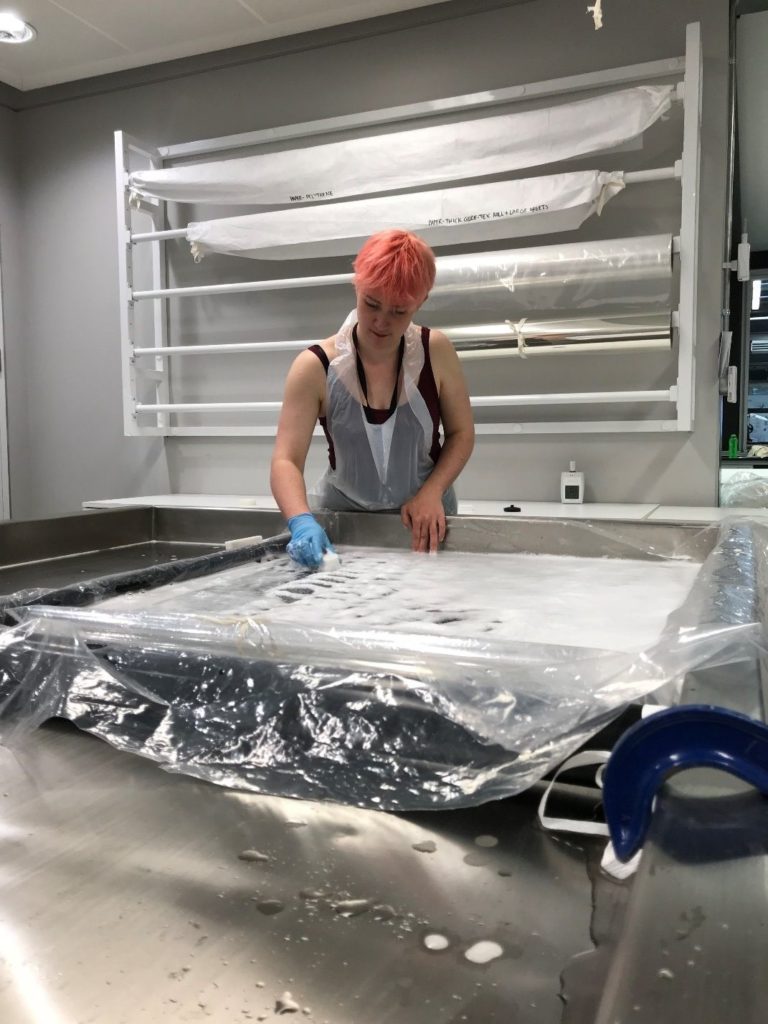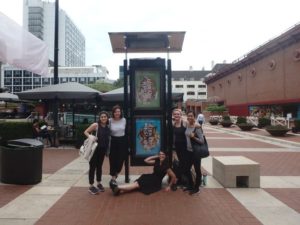
In this second part, three students give an overview of their experiences of placements based in London and of sharing their experiences once back in Glasgow at the placement presentations.
Emma (The British Museum )
I carried out a 9 week placement at the British Museum within Organics Conservation, largely working with the four textile conservators in the department. My initial degree was in Archaeology and Anthropology, and so I was excited to work with the extensive archaeological and ethnographic textile collections in the BM. While on placement I was able to work on around twenty objects to varying degrees of complexity, allowing me to really firm up the skills learnt in the first year at the CTC.

Some of these were full treatments of objects that required several different methodologies, some were simple humidification or surface cleaning of textile elements before the objects were passed on to conservators in other disciplines for further work. Largely the placement was focussed on conserving textiles for the new Islamic galleries due to open soon, however I also had the opportunity to work with mineralised textiles from the Britain, Europe and Prehistory Collections, assess objects from the Ancient Egypt and Sudan collection, and mount and carry out monitoring on textiles in the Hotung gallery. I was able to spend an additional week at the British Museum at the beginning of September in order to continue work on X-raying, documenting and repacking some of the mineralised textiles from the BEP collections, as well as setting up some initial tests for my hopeful dissertation topic on the
storage of archaeological textiles.
Charlotte (Victoria and Albert Museum)
During my ten-week placement at the V&A Museum I was able to conserve several objects for exhibition and loan. Through these I gained experience with a range of conservation treatments and valuable practical experience. My first treatment was on an Edwardian dress which belonged to Heather Firbank, an English socialite whose costume collection was donated to the V&A. The dress required humidification to its pleated skirt, stabilisation of its beaded decoration and mounting onto a mannequin for display. Another object, a 19thC. Sri Lankan man’s waist cloth (measuring four metres in length!) needed two targeted treatments before it could be sent on loan to a display at the Los Angeles County Museum of Art. The first was to remove the fold lines using a large cold poultice treatment (a form of humidification) to relax the fibres of the cloth and remove creases. The second treatment was to strengthen areas of loss. For this, cotton fabric was dyed with NOVACRON® dye to achieve an exact colour match to the cloth. These patches were then applied with conservation stitches in discrete single-ply Stabiltex® monofilament polyester thread. The placement experience was an incredibly valuable opportunity to learn in a real museum environment. I am very grateful to my supervisor at the V&A, Joanne Hackett for the experience and wide range of objects which I was able to work with. So far the summer placement has been a real highlight of my time on the MPhil programme.
Clara (The British Library)
This summer, I carried out a fantastic six-week placement at the British Library. I experienced the diversity of a conservator’s role, saw how it contributed to the wider aims of the institution, collaborated with many people from inside and outside the BL, and encountered some truly incredible objects. One of my main projects was a support treatment for a set of books with degraded silk bindings, returning them to a state where they could be safely handled and digitised. I worked with a book conservation intern, enabling us to learn about each other’s disciplines and giving me new experience of teaching and project management. I also treated two archaeological silk fragments, and it was really exciting to be able to increase accessibility, knowledge and interest in the objects through my conservation work and subsequently through social media. Alongside these projects, I had opportunities to learn about cleaning with gels and chelating agents, help with an exhibition installation, and participate in public engagement events, to name just a few. Having started at the CTC completely new to textile conservation and ending my year working at the BL, the placement truly highlighted for me just how much I have learned in a year!

Those of us undertaking placements in London also had the opportunity to take a day to visit each other’s studios. It was a jam packed day which started at Hampton Court Palace to visit the textile conservation studios on site. We had a wonderful morning learning about the upholstery, costume and tapestry conservation taking place there, and would like to thank all of the conservators at Hampton Court for taking the time to show us the projects they were working on. We then headed back into central London to visit each other’s studios, first the V&A, then the British Museum, and finally the British Library, before heading for a well-deserved pint!
On returning to the CTC for the second year, we had the chance to share our placement experiences with staff and students of the CTC, as well as the trustees of the Textile Conservation Foundation, with an afternoon of presentations. This was a great chance to reflect on what we had learnt on the placements, and especially to give the new first years an insight into what we had been up to over summer.
We would like to thank our placement hosts for such wonderful summers, as well as our funders without which the placements would not be possible – specifically the James McNeil Whistler & Beatrix Whistler scholarship, the Zibby Garnett Foundation and the Textile Conservation Foundation.





